Nests of of Harvest Mice (Micronomys minutus) , the UK’s smallest rodent, were first found at Thames Road Wetland in 2014, when 7 were discovered in the course of vegetation management work. None were located in 2015, but another three were come across in 2016. Both still and video images have now been obtained of this elusive species, which has only been recorded in 5 other London Boroughs over the last 20 years. Found in England and Wales, it is now a Biodiversity Action Plan priority species on account of a 71% decline up to the last review in 2007.
A cunning plan to ‘see’ the Mice themselves
Inspired by an article in ‘BBC Wildlife Magazine’ about the work of a PhD student studying Harvest Mice – see
TRW Site Manager Chris Rose, who operates under the umbrella of the Thames21 waterways restoration charity, installed a series of feeding tubes made of plastic drinks bottles in 2016, regularly replenishing them with bird seed, in order to habituate the animals to using known filmable fixtures in their environment. The tubes were situated in such a way as to make it difficult for anything larger and heavier than a Harvest Mouse to gain access.
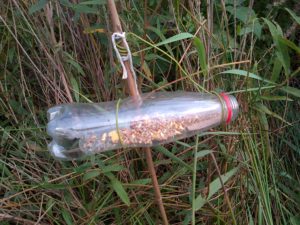
Mark2 ‘safety’ design of Harvest Mouse feeding tube, baited with birdseed. ‘Escape hatch’ at rear in case the bottle comes loose and tips up. A raised flap forward of this stops the wind shaking out the seed. Fabric sticking plaster taped into the neck aids grip and exit at the mouth end. (Photo: Chris Rose)
At the end of October two Little Acorn camera traps, paid for by Thames21 from grant funding, were set up by Chris, Joanna Barton (Assistant River Cray Project Officer for T21), plus volunteers Ray Hudson who supplied the DIY skills, and Wren Rose who has done the work since of trawling through the camera SD cards and extracting the best imagery.
We have had some technical issues, the first of which is a basic limitation of the devices, in that they are designed to capture big animals at some distance, not tiny Mice a couple of feet away. The second is that we set them up to take an initial still and then trip to video. The video should continue for some time longer than the few seconds per clip we have got to date. If anyone is familiar with this make of camera trap and can offer advice on fixing this problem, please get in touch. Meantime we have set them to video only.
Harvest Mice take the bait and appear on-screen
The birdseed in the various feeding tubes has repeatedly been reduced to husks, and Harvest Mice have now appeared in front of the cameras. The following are some of the best images obtained so far. They are undoubtedly the only ones ever taken to date of Harvest Mice in Bexley, possibly the only ones of the animal itself in London – certainly in the last few years – and may be the only film of wild Harvest Mice in the capital.
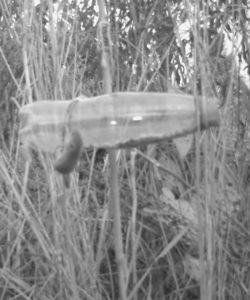
Harvest Mouse climbing up to feeding bottle at dusk on 17th November 2016. Camera trap in night-time mode.
Video clips of Thames Road Wetland Harvest Mice (large files, will take some time to download to your computer for viewing):
harv-mouse-video-clip-9th-nov-2016-imag0145
harvest-mouse-cam-1-trw-17th-nov-2016
The status of Harvest Mice in London
Few records exist, and those that do are largely of nests or of a dead animal. According to Greenspace Information for Greater London (GiGL), the London biodiversity records centre, Harvest Mice have only been recorded from 6 London Boroughs since 1996 – Bexley once before, Bromley twice (Churchill Plantation, Hang Grove Farm), Barking and Dagenham twice, Barnet twice, Havering four times and Redbridge five. Unsurprisingly, with the exception of Barking and Dagenham, these are all on the periphery of London. Prior to the TRW nests of 2014 there had been no (reported) London records since 2010.
Where did the TRW animals come from, and when?
Aerial photographs from the late 1930s and during the war suggest that TRW did not provide suitable habitat for Harvest Mice at that time, and an early 1980s photo shows an overgrazed field similarly devoid of the necessary vegetation structure. Although it was better by the mid 2000s, the extensive work to create the wetland in late 2007 would probably have resulted in the loss of any Harvest Mice that might have been present at that time.
Colonisation (or recolonisation) could have come from one of three possible sources:
i) From the south along the railway line to Dartford.
ii) From a separate population on Stanham Farm, including the River Cray margins, to the south of TRW
iii) Over the Thames Road railway bridge from Crayford Marshes. The previous Bexley record was of either a single nest or a single animal (it is not stated which) in the reedbed at the Erith saltings by the Yacht Club, made in 2007. There could still be a population spread across Crayford Marshes, and this may have at one time been continuous with any animals that survived south of the road. The road itself has, however, long been of a width that research says Harvest Mice would not cross at ground level.
A fourth though probably unlikely alternative is that a female was dropped alive by a predatory bird.
Six of the seven nests found in 2014 were spread along a linear feature over quite a distance, with a seventh some way away on the other side of a waterbody. This suggests the species may have already been present at TRW for a year or two, although the nature of the vegetation management up to that point suggests that if nests had been present in previous years, at least one or two would have been found.
Habitat and behaviour
The name Harvest Mouse is suggestive of an animal that is confined to or very strongly associated with arable farmland, but in practice wetland with reedbed is an important habitat type for the species. At TRW occupancy appears to be greatest in an area over shallow water with a mix of dense Sedge bed, a moderate amount of Common Reed and adjoining grasses on a bund by a ditch. Reedmace on its own, which is a major component of the site’s vegetation, does not appear suitable for nest-building.
We have been somewhat surprised by the extent to which the Harvest Mice have been active in daylight. This may be to do with fattening up for winter (though they do not hibernate) or possibly avoiding competition/interaction with Wood Mice and Rats, though we do have one poor quality night-time photo where a Harvest Mouse is climbing up to a feeding bottle which appears to have a Wood Mouse already in it.
Is the population growing or declining?
We cannot determine this on the basis of current information. Small mammal numbers can fluctuate greatly for a variety of reasons. Autumn is a good time to try and get film because numbers of animals will be at their highest post-breeding, and before winter mortality.
Predation pressure will largely be coming from Foxes, and possibly Weasel (one was ‘captured’ by one of the cameras recently, establishing a new site record). A very occasional domestic Cat is seen, though none in the main Harvest Mouse area. Whilst birds of prey frequently overfly the site, the main prey of the species seen are other birds.
Other rodents
The cameras have also recorded Wood Mouse. The following pair of images shows the difference between Wood Mouse (left) and Harvest Mouse (right) , particularly in the size of the ears:
The local Brown Rats have also proven themselves rather more acrobatic than expected:
Further study and conservation
It is clearly important to try and maintain and build numbers of the mice at this location, in which there is an area of relatively low wildlife interest that could be made more suitable for them by using ‘spare’ shrub suckers from elsewhere on the site to create a low grass-edged hedgerow.
The nature of the site would make it a good one for any student interested in pursuing a more detailed project about Harvest Mice to work on. It would also be invaluable to establish the distribution of the species across the wider local landscape. Please contact Chris Rose on chrisrose@gn.apc.org if you are interested.
Thus far the Mice, and several other rarities at the wetland, will have benefitted from the fact that although the whole site – which falls within a Site of Metropolitan Importance for Nature Conservation – is open to the public, the location and layout of it has meant that in practice very few people wander round unaccompanied and therefore the amount of disturbance and random trampling is minimal, and there are no dogs being allowed to run amok. This state of affairs needs to be maintained. Guided tours are run for time to time for those who are interested.
Chris Rose. Thames Road Wetland, Thames21 (volunteer) Site Manager.
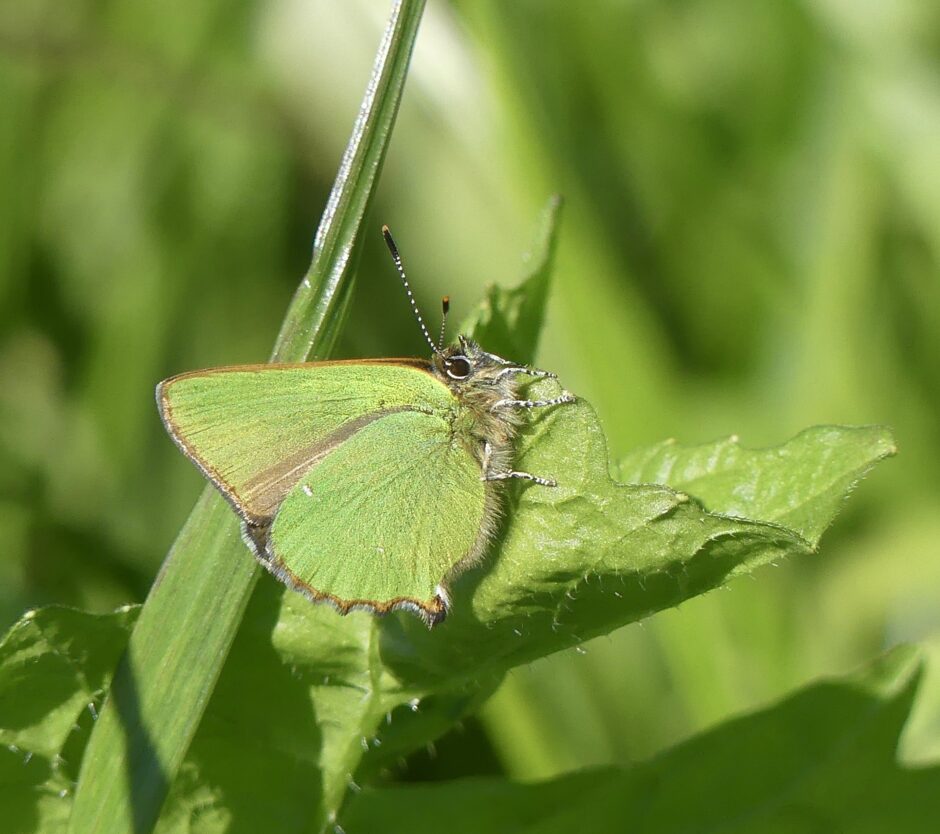
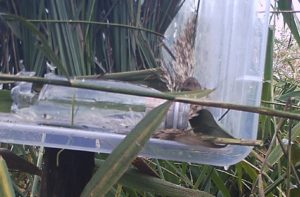
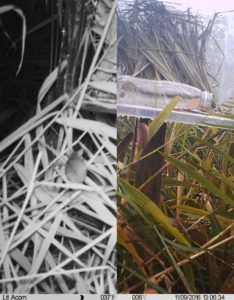
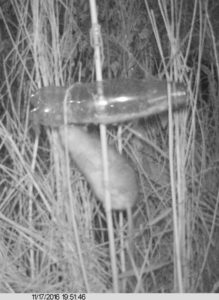
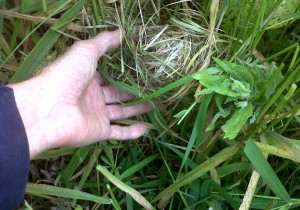
Great work Chris and co,
Very thoughtful work and innovative design of plastic bottle feeding tube to set stage for recording by camera trap. Enchanting video of Harvest Mice and very nice still pictures.